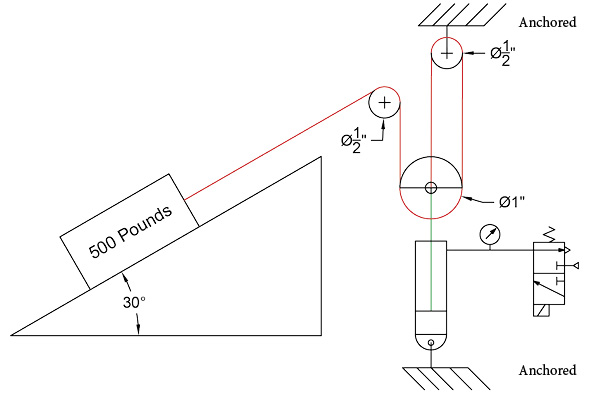Problem: Calculate This

Given:
Coefficient of Friction: .2
Cylinder: 4″ x 20″ x 2″
1. Calculate the pressure to retract the load.
2. Calculate the distance that the load can move.
3. Calculate the pressure to hold the load.
Find Out The Solution
Answers 107+ PSI, 60 inches of travel, 52+ PSI
Solution Part A:
Step 1: Sin of the angle and the load:
Sin of 30 = 0.5 x 500 lbs. = 250 lbs. to overcome gravity.
Step 2: Cosine of the angle x the load x the Cf:
Cos of 30 = 0.866 x 500 x 0.2 = 86.6 lbs. to overcome friction.
Step 3: If going uphill, add the two answers. If going downhill, subtract the two answers.
250 lbs. + 86.6 lbs. = 336.6 lbs. to pull up the incline.
Note: If you are holding a load, subtract the two answers. If step 2 is > than step 1, you will have to pull the load downhill by the difference between the two forces.
The pulley on the end of cylinder has three (3) strands on the moveable pulley, and pulling on the cylinder will be 3x harder to pull than a straight pull up the incline. Pulling the cylinder a foot also means we have to add 3 ft. of cable and that can only come from the load.
336.6 x 3 = 1009 lbs. of pull on the cylinder Rod end area = 12.566 – 3.14 or 9.42 sq. in.
F = PA 1009 / 9.42 = 107.2 PSI
Part B: 20-inch stroke x 3:1 mechanical disadvantage = 60 inches of travel
Part C: To hold the load, we can subtract the friction (step 2) from gravity (step 1)
250 – 86.6 = 163.4 lbs.
163.4 x 3:1 mech. disadvantage = 490 lbs. to hold the load on the cylinder
F = PA 490 / 9.42 sq. in. = 52.15 PSI
Note: With air, one would generally give an extra 30% air pressure to give enough force and speed.
Deadline past. Not available for submissions.
Winner
Mark Sterrett, CFPHS, RH Sheppard Co., Inc.
Answered correctly
Ehren Polheber, CFPS, Scot Forge Company, Salem, WI
Dan Jensen (student), CFPS, Hennepin Tech, Excelsior, MN
Kirk Miller, Orbital ATK
By Ernie Parker, AI, AJPP, AJPPCC, S, MT, MM, MIH, MIP, MMH, Fluid Power Instructor, Hennepin Technical College, EParker@Hennepintech.edu
This teaser is printed in the Fluid Power Journal. Those who submit the correct answer before the deadline will have their names printed in the Society Page newsletter and in Fluid Power Journal. The winners will also be entered into a drawing for a special gift.
1. Calculate the pressure to retract the load = 88,76
2. Calculate the distance that the load can move 3X20=60
3. Calculate the pressure to hold the load = 79,5 PSI
my mistake:
i calculated with the friction force only once. But with the 3:1 mechanical disadvantage i have to ad 3 times in the calc.
my revised results:
107 PSI uphill
52 PSI holding
60 distance
revise my calc:
i calculated with the friction force only once. But with the 3:1 mechanical disadvantage i have to multiply 3 times.
my revised results are :
107 PSI for uphill
52 PSI for holding
60 travel
1. Pressure to retract the load = 50.67 psi
2. Calculate the distance that the load can move = 19.5/3 =6.5 inches (deduct 1/2′ for pulley)
3. Pressure to hold the load (Cf = 1) = 60.93 psi